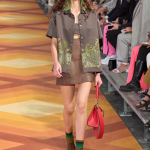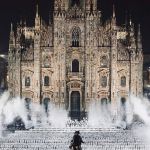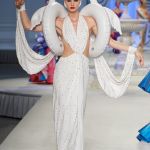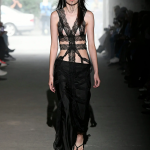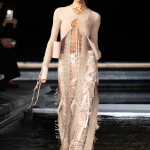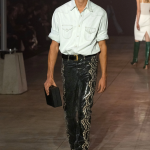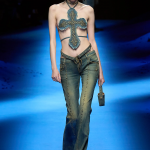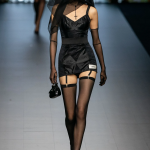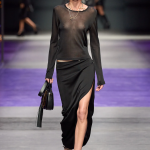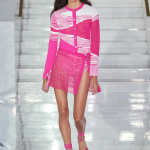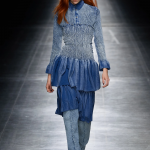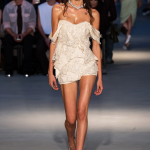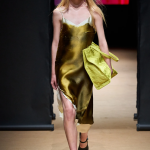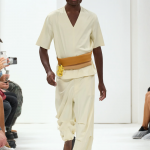
A season of chaos and ecstasy in Milan
Designing a collection is easier than finding a cab in the city these days
September 26th, 2022
Debuts, delays, elections: these were the three main themes of the just-concluded Milan Fashion Week. The debuts were those of Maximilian Davies at Ferragamo, Marco De Vincenzo at Etro, Rhuigi Villaseñor at Bally, and Filippo Grazioli at Missoni. Delays, on the other hand, were a bit of everyone's business-with editors or whoever running across town in worrying numbers of cars, with fashion shows starting an average of an hour late, constant problems with dead phones and traffic completely jammed after each show. And finally, the elections were the backdrop against which all the various and alternating events of the Milanese brands unfolded - a backdrop that in some ways detracted with its importance from the frivolity of dresses, faux-furs, bags and heels-without-heels that dominated this season's womanswear collections. If there is a common thread that can be found in the many different collections presented during the week, it was the relative cleanliness of the silhouettes, the absence of shouty logos, and the general search for a new commercial koine based on an underlying essentiality mixed with a certain amount of sensuality that much of the international press found bland and unradical. The best in summing up these instances was Blazy from Bottega Veneta who, speaking in his show notes of «perverse banality», of «erotismo dell’ultra-sofisticazione attraverso la sartoria», of «eroticism of ultra-sophistication through tailoring,» and of «souvenirs worn by a globe-trotter» created a sum of the main thematic and aesthetic directions of the season.

Jil Sander
The search for essentiality is even more evident when one considers how the two most normally baroque and maximalist names of the week, Versace and Dolce & Gabbana, veered away from the old-fashioned extremities, forgoing golds and patches, and opting instead for more monochromatic ensembles that told the aesthetics of their respective brands in a more implicit and structural way than in the past. Particularly interesting was the operation of Dolce & Gabbana, who offered the audience a selection of archival looks filtered through the contemporary lens of Kim Kardashian's sensibility - the result of which, aside from the obvious marketing appeal, resonated more sincerely and elegantly than many of the two designers' past collections. Elsewhere, however, conceptuality and technicality dominated the aforementioned Bottega Veneta collection, but also the outings of Prada, Jil Sander, and MaxMara that were essential bordering on avant-garde. At Gucci, on the other hand, the avant-garde turned into a tightrope show, with the gimmick of the double runway show populated by twins reminding Milan that a fashion show can be something more elaborate than a simple review and that fashion is still capable of creating a spectacle capable of surprising and being remembered. More direct, on the other hand, was Moschino, which, indulging in a fantasy with 80s flavors, evoked fashion shows and silhouettes from other and more opulent times with a modern and ultra-ironic flair. Similarly, Moncler turned its show into a pharaonic spectacle with two thousand dancers present in Piazza del Duomo-a new demonstration of the creative possibilities of a show, outside the format of the classic "review."
Essentiality was then seen at work at Ferragamo, which the restyling operated by Maximilian Davies has already colored with a new patina of charm and novelty that the brand had abundantly lost in recent years. Davies has a complicated task in front of him: a designer who comes from effervescent London found himself within the ancient, heavy walls of a stately Tuscan home as opulent as it is old-fashioned - yet last Saturday's show proved that a restyling is possible and that Davies is the right creative figure to make the historic brand relevant and vital again. Similar operation, in a more controlled form, was carried out by Rhuigi Villaseñor with Bally, which recalled Tom Ford's Gucci but in a less decadent key. On the other hand, an air of decadence was blowing at Blumarine, Diesel, No. 21, Andreadamo and AC9, which presented a series of sensual and discreet looks inspired by a kind of morbid libido made up of transparent or reduced dresses, with draping straps, dropped straps, cuts that revealed, straps and hems of torn lace, and almost ragged silhouettes. In particular, the muses that Alessandro dell'Acqua brought to the runway seemed to be a portrait of an extreme, romantic elegance that had survived a shipwreck that unraveled codes, broke symmetries, disrupted social norms.
And if indie brands such as Cormio and Sunnei have avoided big statements by proposing a revisited, vaguely eccentric normcore, as Andrea Incontri also did for his inaugural show at Benetton and in a pop key Massimo Giorgetti at MSGM, Rocco Iannone's Ferrari has continued its stylistic evolution by moving toward a contemporary and wearable silhouette, reworking above all an iconic element present in the brand's imagination and that is the iconic racing suit that is proposed both in a form close to the real thing, with the brand colors and related logos, and in a more sophisticated, leather version. Significant, on the other hand, is the fashion show of Tokyo James, perhaps the only designer this season to convincingly fuse social, personal and commercial instances in a show that did not seem creatively dependent on any other inspiration but was on the contrary cohesive, focused and precise as a laser but above all represented the only outing of an independent designer with a strong and decisive voice and a vision unencumbered by commercial needs and rhetorical stunts of any kind. A designer who, we hope, will continue to use Milan as his platform and keep his independent scene alive.

















































